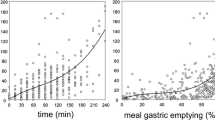Abstract
Bioavailability is the fraction of an administered dose that reaches the systemic circulation. Health claims for functional foods can only be made if the ingredient reaches the target site to trigger the physiological action, hence substantiation requires good bioavailability. This is also expressed in the European Regulation on Health Claims. Albeit not new at all, a full understanding of the controlling factors for bioavailability in foods is still lacking. Foods are complex systems and can be part of a meal. The impact of product composition and the interplay with human physiology during fed or fasted state has to be understood: a functional ingredient has to be released from the product matrix into a molecularly dispersed state, either in classic solution or in micellar state. Only in the dispersed state can actives cross the gut wall. Release and dissolution are depending on both molecular physicochemical properties of the active and those of the entire product. More complex is the uptake of hydrophobic, poorly water-soluble substrates. As they do not dissolve in the aqueous intestinal environment, presence of fat, release of bile, enzymes, and gut motility to induce lipolysis are required. Surface-active bile salts together with lipolysis products create micelles containing the hydrophobic active. This imposes limitations on the formulation space for hydrophobic compounds. Finally, many ingredients are not fit for straightforward use as they compromise the stability or sensory characteristics of the product. Compartmentalization strategies, like encapsulation, may offer solutions to the problem; it should, however, not be forgotten that encapsulates themselves may effect bioavailability through the changed dynamics of the uptake processes. To explore and build a better understanding of these factors, a range of models are available and used in product formulation and claim substantiation. A structured approach and the selection of proper models will help to improve functional food formulations in the future.







Similar content being viewed by others
References
L. Allen, B. de Benoist, O. Dary, R.F. Hurrell, Guidelines on Food Fortification with Micronutrients. (World Health Organization and Food and Agriculture Organization of the United Nations, Geneva, 2006) ISBN 92 4 159401 2
M. Vertzoni, N. Fotaki, E. Kostewicz et al., Dissolution media simulating the intralumenal composition of the small intestine: physiological issues and practical aspects J. Pharm. Pharmacol 56(4), 453–462 (2004)
H. Chahinian, T. Snabe, C. Attias et al., How gastric lipase, an interfacial enzyme with a Ser-His-Asp catalytic triad, acts optimally at acidic pH Biochemistry 45(3), 993–1001 (2006)
L. Kalantzi, K. Goumas, V. Kalioras et al., Characterization of the human upper gastrointestinal contents under conditions simulating bioavailability/bioequivalence studies Pharm. Res 23(1), 165–176 (2006)
J.N. Hunt, R. Cash, P. Newland, Energy density of food, gastric emptying, and obesity Lancet 2(7941), 905–906 (1975)
J.N. Hunt, J.L. Smith, C.L. Jiang, Effect of meal volume and energy density on the gastric emptying of carbohydrates Gastroenterology 89(6), 1326–1330 (1985)
A. Pal, J.G. Brasseur, B. Abrahamsson, A stomach road or “Magenstrasse” for gastric emptying J. Biomech 40(6), 1202–1210 (2007)
D. Fennel Evans, H. Wennerström, The Colloidal Domain: Where Physics, Chemistry, Biology and Technology Meet, 2nd edn. (VCH, New York, 1994)
N.L. Trevaskis, W.N. Charman, C.J.H. Porter, Lipid-based delivery systems and intestinal lymphatic drug transport: A mechanistic update. Adv. Drug Deliv. Rev. (2007) DOI 10.1016/j.addr.2007.09.07
G.A. Kossena, W.N. Charman, B.J. Boyd et al., Influence of the intermediate digestion phases of common formulation lipids on the absorption of a poorly water-soluble drug J. Pharm. Sci 94(3), 481–492 (2005)
C.A. Lipinski, F. Lombardo, B.W. Dominy et al., Experimental and computational approaches to estimate solubility and permeability in drug discovery and development settings Adv. Drug Deliv. Rev 23(1–3), 3–25 (1997)
F. Nigsch, W. KJaffke, S. Miret, In vitro models for processes involved in intestinal absorption Expert Opinion on Drug Metabolism and Toxicology 3(4), 545–556 (2007)
S. Lynch, A comparison of methods for estimating the bioavailability of elemental iron food fortificants FASEB. J 20(4), A623 (2006)
S.A. Sarker, L. Davidsson, H. Mahmud et al., Helicobacter pylori infection, iron absorption, and gastric acid secretion in Bangladeshi children Am. J. Clin. Nutr 80, 149–153 (2004)
E.A. Trautwein, G.S.M.J.E. Duchateau, Y. Lin et al., Proposed mechanisms of Cholesterol-lowering action of Plant Sterols European Journal of Lipid Science and Technology 105, 171–185 (2003)
A.M.E. Doornbos, E.M. Meynen, G.S.M.J.E. Duchateau et al., Intake occasion affects the serum cholesterol lowering of a plant sterol-enriched single-dose yoghurt drink in mildly hypercholesterolaemic subjects Eur. J. Clin. Nutr 60(3), 325–333 (2006)
J.M.M. van Amelsvoort, G.S.M.J.E. Duchateau, S.M. Mel’nikov et al., WO 2006/069619 A2: Edible compositions comprising a primary lipid, a co-lipid, a physiologically active ingredient and water, and their preparation. (2006), http://www.wipo.int/pctdb/en/wo.jsp?wo=2006069619&IA=WO2006069619&DISPLAY=CLAIMS
Acknowledgement
Silvia Miret-Catalan and Serpil Tascioglu are acknowledged for the information provided on the iron compounds. Our colleagues from the Food Structural Design Department of Unilever Vlaardingen are thanked for giving us insight on the aspects of food formulation.
Author information
Authors and Affiliations
Corresponding author
Additional information
Both authors are full-time employees of Unilever.
Rights and permissions
About this article
Cite this article
Duchateau, G.S.M.J.E., Klaffke, W. Product Composition, Structure, and Bioavailability. Food Biophysics 3, 207–212 (2008). https://doi.org/10.1007/s11483-008-9076-5
Received:
Accepted:
Published:
Issue Date:
DOI: https://doi.org/10.1007/s11483-008-9076-5




